
Sri Chowdhury, “Affected Painting,” site specific installation: wood, linen, oil paint, concrete, glass, plants, light gels, shadows, ceramics, 2015.
Five shows through June 19th
Vox Populi
319 North 11th Street, Philadelphia
What’s on view: Three solo shows, and a plant-centric group show curated by Caroline Picard. A giant T-shirt, an old phone connected to a voice message, posters celebrating vaginas, a seed vending machine, and a cat feeder that looks like Donald Trump are among the more fun highlights in the project spaces.
Michael: I like this collection of small shows because it’s like a survey of what’s hot on the NADA circuit without being as polished or obnoxiously-soul-less as an art fair. (How sad is it that art fairs now feel like the default art-viewing point of reference?) Houseplants! Oversized clothes! Cartoonish vaginas! These are all trends we’ve talked about before, and they’re all trends I’m 100% on board with. Sri Chowdhury’s installation is the first thing you see walking into the space, and I can’t think of another piece that’s as easy to fall in love with. It’s really evocative of a stained glass window or sets from the original Star Trek, but you can walk behind the composed screen and see the messy contraption that projects the image. I’d love to see this at night. I for one am glad plants are everywhere these days—they’ve gotta be cleaning out the nasty VOCs left over in galleries’ air from all the oil-and-spray-paint provisional painting that was this ubiquitous a few years ago.
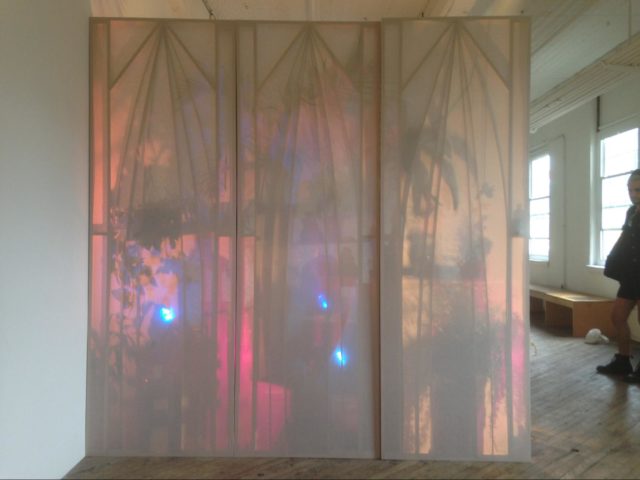
Sri Chowdhury, “Affected Painting,” site specific installation: wood, linen, oil paint, concrete, glass, plants, light gels, shadows, ceramics, 2015.
Imperceptibly and Slowly Opening
What’s on view: a plant-centric group show curated by Caroline Picard. With work by Sebastian Alvarez, Srijon Chowdhury, Katy Cowan, Zoe Crosher, Lindsey French, Essi Kausalainen, Steve Ruiz, John Steck Jr., Linda Tegg, & Andrew Yang
Whitney: I think it’s safe to say by now that plants are no longer a trend; they are a medium (except for potted palms). The intimate scale and light touch like a feminine, intellectual antithesis to Earthworks’ macho-ness. The loving scattering of little clumps of dirt and treasured seeds– like Andrew Yang’s Kentucky Coffeetree seeds in a gumball machine– nurtures the landscape rather than the Art impulse to roll out a bulldozer.

Andrew Yang, “New Economies of Anachronistic Fruit,” Site specific installation with gumball machine, seed pods, seeds, Kentucky Coffeetree, 2015.
Kind of separate from that is Sebastian Alvarez’s timeline of drugs derived from plants, which is illustrated by a long horizontal branch sprouting various species of flowers and leaves. For example:
- in 1492, one of Columbus’ crew brings tobacco smoking to Europe for the first time
- in 1500, China establishes the medicinal use of pure opium
- in 1995, Bill Clinton legalizes the use of peyote by members of a Native American church
- etc.
It made me stop to think about how much plants shape international politics. I take plants for granted.
I do wish more of the artists’ backgrounds were visible (though I don’t know how you’d do that without making people read a bunch of wall text or providing work documentation). When I googled their names, I found lots of strong botanical statements, which aren’t clear here: Andrew Yang has made philosophical arguments nature as art, Linda Tegg recreated pre-colonial grasslands at the State Library in Victoria in as a political statement, Zoe Crosher initiated a series of artist-made billboards along I-10 from Florida to California. With such an ambitious group, you’d think more could grow/hang/jump off the walls.
Michael: Yeah, I had some mixed feelings about how this was curated. I really loved Sri Chowdhury’s piece (see at top), but felt that the rest of the show was a little sterile. It took me a minute to realize this was a group show—at first I thought this was another solo project and this room was showing some sort of research-based supplement to the installation. Obviously, that’s not the case because there wasn’t much in the way of the didactic here beyond Alvarez’s timeline. John Steck’s “Disappearing Photographs” were blank by the time we saw them, and Lindsey French’s vial of mystery liquid just didn’t give us enough information. This was one of the few times I thought an exhibition would be nicer as a catalog than in a gallery (indeed, there’s a catalog coming out in the fall), with a few notable exceptions.
I think I liked Linda Tegg and Essi Kausalainen’s respective videos more than you did. In Tegg’s “Human Plant Movement,” we see a bunch of plastic, industrial-looking trays of plants in a pile on the floor of an empty room. They quiver and bounce—presumably there’s a person hiding under them—like they’re dancing in the sunlight coming in from the window. Kausalainen’s videos are also cute and a little absurd—actors cycle through goofy motions interacting with houseplants, because really, what are you supposed to do with these strange living things we collect? They remind me of a piece/anecdote from the photographer Milana Braslavsky, which depicts a figure ominously crouched behind a houseplant in a suburban home. She told me that her family thought houseplants were really weird when they first moved to the U.S. from Azerbaijan, like, “Why would you put a tree inside?” I guess we don’t really know, other than the fact that some varieties can get you high.
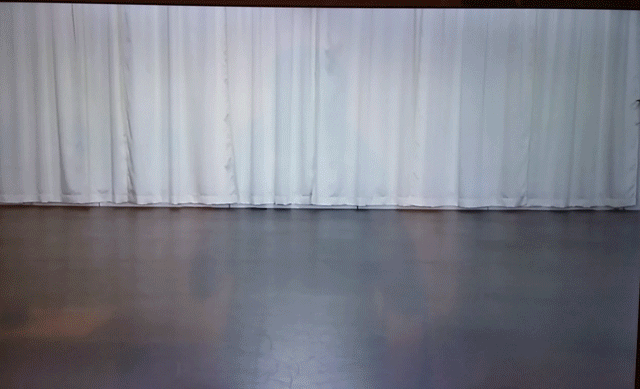
Essi Kausalainen

Matt Kalasky, “strive to be a complex and unique individual whose worth is determined not by your ability to consume or produce but by the innate and earnest expression of your humanity,” 2016.
Matt Kalasky: All Time Top Phonies
Through June 19th
Vox Populi
319 North 11th Street, Philadelphia
What’s on view: A giant oversized T-shirt that reads “BE YOU” (or something along those lines), a bizarre contraption featuring a lumpy papier-mâché Donald Trump face, and a mural with the title “TWO MATTS TEACH ONE MATT ABOUT NIRVANA the BAND” featuring the PBS logo and a faux-typewritten paragraph:
“Kurt comes to the board because you know it is is his turn but he is thinking to himself he is thinking what should I write? WHAT CAN I SAY? He wants it to be something true something hopeful something that will SHUT UP (once and for all) these freaking fascist capitalist pigs these these racists so & sos these straight white hyp-o-crite pretenders THAT is what he is thinking about but what he really is thinking about what his best case scenario is is something father would disapprove of but something mother would not mind”
Whitney: Michael immediately recognized this cat food dispenser as Donald Trump’s head, and as soon as he pointed it out, it was blatantly obvious: the pancake of hair and the squinty little eyes atop a hole-shaped mouth makes a perfect dispenser for Advil (which it spews twice daily, and rolls down the chute). The image of Donald Trump puking Advil in exchange for abusing our ears is beautifully cathartic. Matt Kalasky’s basically the resident artist/writer/comedian here, and this does a great job of combining those powers. Bra-fucking-vo.
PS- normally it makes me a little uncomfortable when John Oliver/Jon Stewart/Trevor Noah make fun of politicians’ voices and appearances– it’s a cheap shot, and the right doesn’t even seem to go there. Except for Trump, so in this case, fair game.
Michael: It kinda looks like someone projection-mapped an image of Trump’s face onto Pepe the Frog’s head, which is as good of a thing as any to do with Trump’s face, I guess. The title of this exhibition is All Time Top Phonies. Was Kurt Cobain a big fake like a Republican politician/purveyor of questionable degrees and low-quality steaks? I’m not sure, but fake-liking Nirvana (at least through T-shirt purchases) is a well-documented thing millennials tend to do. Maybe buying a fake-vintage Nirvana shirt is kinda like wearing a giant “BE YOU” shirt. At any rate, I liked this show, even though I still can’t figure out wtf is going on with all the giant clothes art everywhere.
Whitney: Same! You pointed this out to me a year ago, and by then it was already a thing.
Julia Staples: Your Best Life Now
What’s on view: A dimly-lit room, dominated by a plywood ziggurat, with sculptural and photographic tableaus against the walls. Next to a homemade-looking wooden chair, there’s a notepad and old phone.
Whitney:
Note reads:
Life Energy Sources
Sonny Lopez
Pick-up to talk
$4.95/minute
Tonight special promotion
Free
Ask a question
Get an answer
I called the hotline, and I got the answering machine: “This is Sonny, leave a message.” I asked whether I would ever touch a whale. Nobody called back.
A similar piece is the subject of Jonathan Lethem’s book You Don’t Love Me Yet; a woman mans the phone line in a gallery for an artwork called “Complaint Line,” where people can call in and air their complaints. I’m not a fan of that book, nor do I think that would make a particularly great work of art, but I bring this up because, although that’s a fictional artwork which sounds like a relational aesthetics parody, it’s still enough of a jumping-off point for a book. I understand that there’s some tragedy in asking a question into an abyss via a dying technology, but I think any seasoned art-viewer will fully expect no one to pick up, because it’s time-consuming to man a phone, and art is deadpan. But why not?? If there’s a phone, use it! Even a fax or a beep or a robo-call.
Michael: I am wary of phones in galleries, because one time I had to walk through a treacherous plexiglass maze to get to a phone that Yoko Ono “might” call “when she feels like it.” But that’s a different story. This room gave us just enough to look at to be evocative, but was very open ended. I’m not sure why I found that so satisfying. The rainbow made out of bent broom handles against a found image of sky was oddly endearing and kind of sad. Everything in this installation felt like some kind of futile self-help stopgap.
Whitney: I feel we should also address the large wood structure.
Michael: I liked it. It reads as a DIY kaaba or other improvised monument. That monolithic vibe was reinforced by how big it felt in a small, not-very-well-lit space. Like most of Staples’ work, it seemed to pose a question.
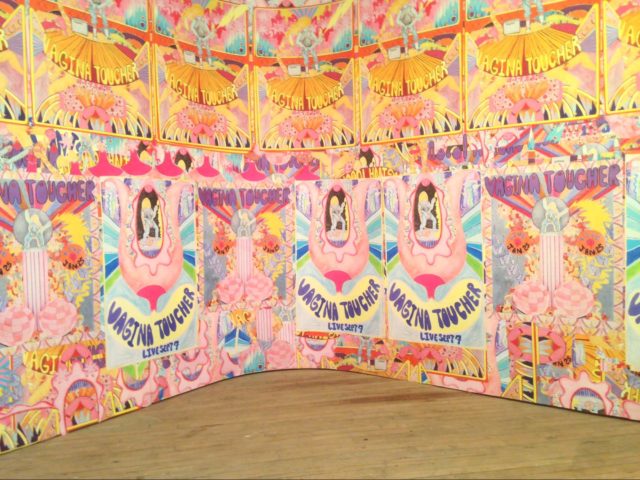
Jesse Harrod
Jessie Harrod: Toxic Shock and the Hotdog
What’s on view: Genitalia-like yarn hangings, a drawing of pussies pissing and crossing streams to form a pack of cat heads in the clouds, and a mural of posters of a girl rockstar titled VAGINA TOUCHER
Whitney: Note that in the poster, she’s playing a dick hooked up to an amp and shooting lightning bolts. I always hated jam bands because I feel like I’m watching a bunch of dudes jerking off, so it’s gratifying to see a girl strap on the dick and jizz all over the place. That’s probably a personal view.

Jesse Harrod
Michael: I want to know what VAGINA TOUCHER sounds like, and I feel like it would be something along the lines of Riot Grrrl with saxophone solos and I would probably love it. It’s worth noting that the posters are hung in a curving semi-circle around the viewer, so you’re enclosed by a panopticon of vaginas returning your gaze. I think the 2-D work is much more bad-ass than the phallic yarn pieces, because those feel like a bit of a cliché at this point.
Whitney: Yeah, I don’t think “VAGINA TOUCHER” needs to be abstracted in yarn. Too subtle?

Jesse Harrod, “Mascots,” 2016.

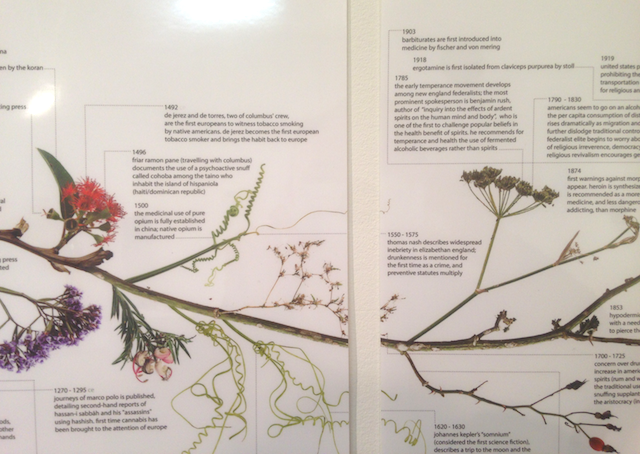
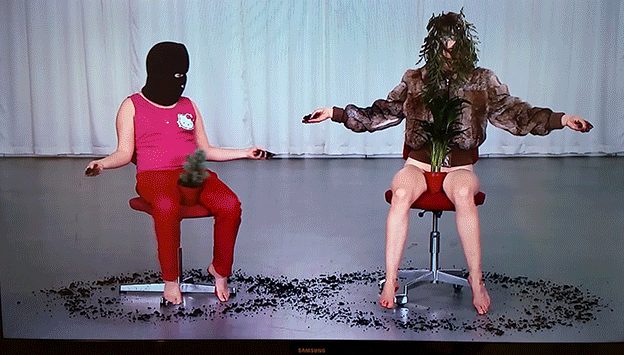
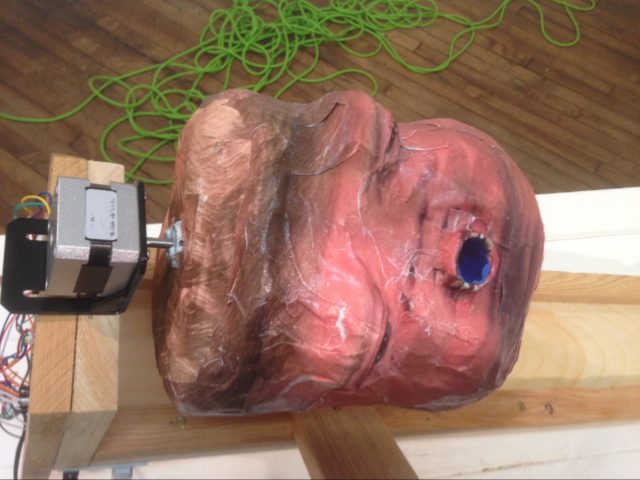

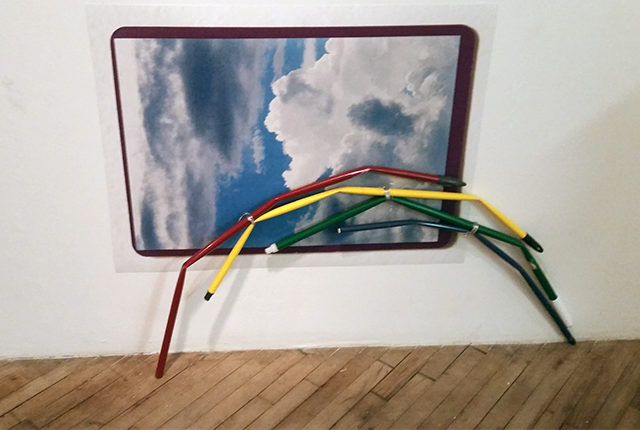

Comments on this entry are closed.
{ 1 trackback }